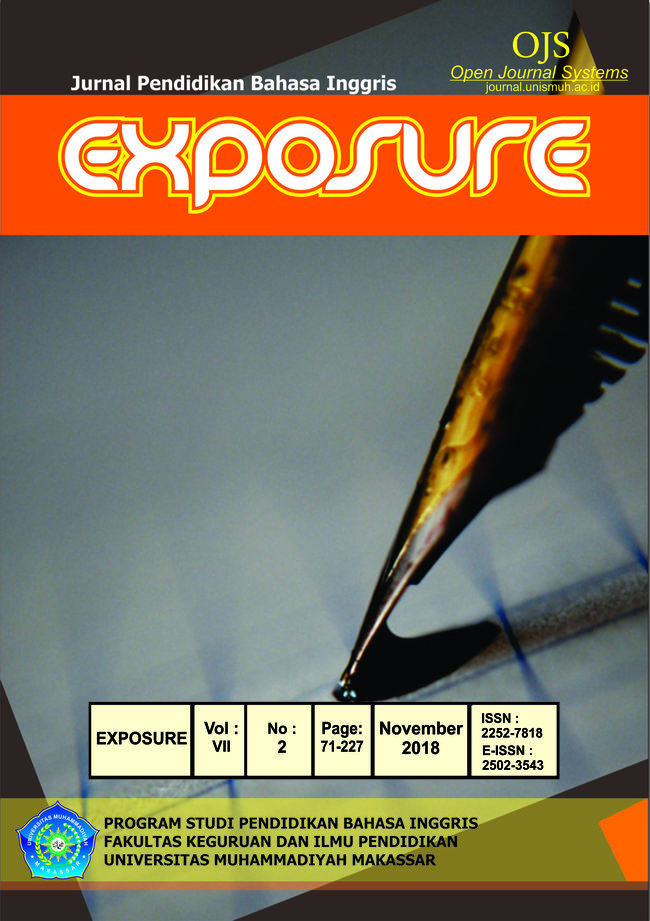PUBLIC SPEAKING INTENSIVE COURSE FOR STUDENTS OF NON-ENGLISH DEPARTMENT (A Study in English Language Centre)
DOI:
https://doi.org/10.26618/exposure.v7i2.1510Keywords:
public speaking, intensive courseAbstract
Many strategies have always been used to improve students’ speaking ability, especially how to speak in front of public. To speak in public, people need to have good abilities both in verbal and non-verbal. An intensive course program of public speaking held by English Language Centre (ELC) of Universitas Muhammadiyah Ponorogo (UMPo) has been used as the program preference to enhance students’ competence in public speaking for last two years. This study aims to investigate the program of that teaching; public speaking intensive course helps students raise their speaking competency and reduce their anxiety. At the beginning of the semester, pre-test of public speaking is given to the students to know their ability before joining the program. At the end of the semester, the students are given post test and questionnaire. The questionnaire is also given to 6 instructors who involving in teaching public speaking program. The result of the students’ scores after following this program indicates that this program is successful to enhance their public speaking. The questionnaire given to the students also reveals that they can build their confidence or reduce their anxiety in speaking. This evidence is also supported by the results of questionnaire given to the instructors for asking their perception after completing this program. The result of perception entails that this program is appropriate for all students, particularly those who have passion in public speaking and want to get more benefits from it.
References
Dwyer, K. K., & Davidson, M. M. (2012). Is Public Speaking Really More Feared Than Death? Journal of Communication Research Reports.
Lucas , S. E. (2010). The Art of Public Speaking 10th ed. New York: McGraw-Hill.
Mufanti, R. (2015). The Supporting Factors and Barriers of Students Communicative Activities in a Speaking Class. Proceedings Teaching and Assessing L2 Learners in the 21st Century, 326-332.
Mufanti, R., Gestanti, R. A., & Nimasari, E. P. (2017). Can I be a Public Speaker?: Get Ready for Speech 2nd Edition Book. Ponorogo: Nata Karya.
Nimasari, E. P. (2016). How do undergraduate students avoid plagiarism? Asian EFL Journal, 93-101.
Ronald, C. S., & Melissa, V. (2013). Research on Public Speaking . Journal of Voice and Speech Review.
Westwick, J. N., & Hunter, K. M. (2014). Assessing Success: The Impacts of a Fundamentals of Speech Course on Decreasing Public Speaking Anxiety. Journal of Communication Education.
Hassani, S., & Rajab, A. (2012). General Communication Anxiety among EFL Students; A Case of Iranian Students of Intensive English Programs. Procedia - Social and Behavioral Sciences, 66, 410–418. https://doi.org/10.1016/j.sbspro.2012.11.284
Kosti, M., & Marsa, P. (n.d.). Public speaking anxiety is very common among both college students and the general population.
Öztürk, G., & Gürbüz, N. (2013). The Impact of Gender on Foreign Language Speaking Anxiety and Motivation. Procedia - Social and Behavioral Sciences, 70, 654–665.
https://doi.org/10.1016/j.sbspro.2013.01.106
Raja, F. (2017). Anxiety Level in Students of Public Speaking: Causes and Remedies. Journal of Education and Educational Development, 4(1), 94–110.
Slater, M., Pertaub, D.-P., Barker, C., & Clark, D. M. (2006). An Experimental Study on Fear of Public Speaking Using a Virtual Environment. CyberPsychology & Behavior, 9(5), 627–633. https://doi.org/10.1089/cpb.2006.9.627
Susilo, A. (2013). Academic Controversy Model As An Alternative Strategy For Teaching Speaking At University Level. Cendekia, 11(2), 285–297. Introduction to Public Speaking. https://courses.lumenlearning.com/boundless- communications/chapterwhat-you-can-accomplish-with-public-speaking/ accessed on 22 June 2018.
Downloads
Published
Issue
Section
License
Authors who publish with this journal agree to the following terms:
In order to assure the highest standards for published articles, a peer review policy is applied. In pursue of the compliance with academic standards, all parties involved in the publishing process (the authors, the editors and the editorial board and the reviewers) agree to meet the responsibilities stated below in accordance to the Journal publication ethics and malpractice statement.
Duties of Authors:
- The author(s) warrant that the submitted article is an original work, which has not been previously published, and that they have obtained an agreement from any co-author(s) prior to the manuscript’s submission;
- The author(s) should not submit articles describing essentially the same research to more than one journal;
- The authors(s) make certain that the manuscript meets the terms of the Manuscript Submission Guideline regarding appropriate academic citation and that no copyright infringement occurs;
- The authors(s) should inform the editors about any conflict of interests and report any errors they subsequently, discover in their manuscript.
Duties of Editors and the Editorial Board:
- The editors, together with the editorial board, are responsible for deciding upon the publication or rejection of the submitted manuscripts based only on their originality, significance, and relevance to the domains of the journal;
- The editors evaluate the manuscripts compliance with academic criteria, the domains of the journal and the guidelines;
- The editors must at all times respect the confidentiality of any information pertaining to the submitted manuscripts;
- The editors assign the review of each manuscript to two reviewers chosen according to their domains of expertise. The editors must take into account any conflict of interest reported by the authors and the reviewers.
- The editors must ensure that the comments and recommendations of the reviewers are sent to the author(s) in due time and that the manuscripts are returned to the editors, who take the final decision to publish them or not.
Authors are permitted and encouraged to post online a pre-publication manuscript (but not the Publisher’s final formatted PDF version of the Work) in institutional repositories or on their Websites prior to and during the submission process, as it can lead to productive exchanges, as well as earlier and greater citation of published work (see The Effect of Open Access). Any such posting made before acceptance and publication of the Work shall be updated upon publication to include a reference to the Publisher-assigned DOI (Digital Object Identifier) and a link to the online abstract for the final published Work in the Journal.

